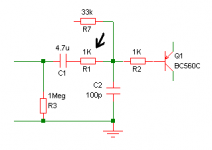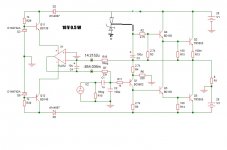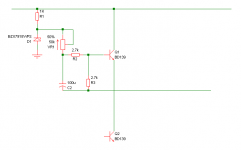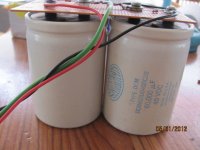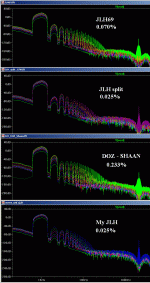Hi guys. Sorry, I was out for some time due to serious net connection failure. How've you been?
An extra resistor should solve it. See the attachment. 1K right after the input cap.
Yup. Zeners. Only one per channel. An 18V zener would be best.
Steps:- 1K resistor from positive rail to zener negative lead. Zener positive lead goes to ground. Disconnect VR from positive rail and connect the pin to zener negative lead. Done. 🙂
Cheers.
I noted 2 minor problems :
1) I notice that it is very sensitive to switches of power supply in other parts of the house. There is a rather obvious thump audible through the speaker.
An extra resistor should solve it. See the attachment. 1K right after the input cap.
2)The bias current fluctuates between 1.5 amp to 1.8 amp.Input V is 22 V to 23 V
Hi, Shaan is there anyway of stabilising these?
Yup. Zeners. Only one per channel. An 18V zener would be best.
Steps:- 1K resistor from positive rail to zener negative lead. Zener positive lead goes to ground. Disconnect VR from positive rail and connect the pin to zener negative lead. Done. 🙂
Cheers.
Attachments
More feedback
Hi all,
More listening impressions through a 93db/1w/m open baffle speakers and powered subwoofer.
It has the signature of JLH 69 but everything is more. More extended bass, more smooth vocals and more extended high.
The timbre of piano is very , very good .
The ambient retrieval is also better. Big drums are protrayed well with the perception of the skin being hit and very nice reverberation of the sound around the recording studio.
Vocal are more detailed and sound very human .
It is more holographic. 3D and sound stage is lifesize with a walk through sensation. This is the most impressive aspect .
Hope to start on the cap multiplier power supply soon.
Shaan
Thanks for the reply. See the attached drawing.
Is this the correct wiring ? I was thinking of retaining the VR in the circuit and regulated the V in the + and _ power supply rail before the amp. In this way you can still adjust the Iq
You are right, I am over the moon !
thank once again
kp93300
Hi all,
More listening impressions through a 93db/1w/m open baffle speakers and powered subwoofer.
It has the signature of JLH 69 but everything is more. More extended bass, more smooth vocals and more extended high.
The timbre of piano is very , very good .
The ambient retrieval is also better. Big drums are protrayed well with the perception of the skin being hit and very nice reverberation of the sound around the recording studio.
Vocal are more detailed and sound very human .
It is more holographic. 3D and sound stage is lifesize with a walk through sensation. This is the most impressive aspect .
Hope to start on the cap multiplier power supply soon.
Shaan
Thanks for the reply. See the attached drawing.
Is this the correct wiring ? I was thinking of retaining the VR in the circuit and regulated the V in the + and _ power supply rail before the amp. In this way you can still adjust the Iq
You are right, I am over the moon !
thank once again
kp93300
Attachments
Hi all,
More listening impressions through a 93db/1w/m open baffle speakers and powered subwoofer.
It has the signature of JLH 69 but everything is more. More extended bass, more smooth vocals and more extended high.
The timbre of piano is very , very good .
The ambient retrieval is also better. Big drums are protrayed well with the perception of the skin being hit and very nice reverberation of the sound around the recording studio.
Vocal are more detailed and sound very human .
It is more holographic. 3D and sound stage is lifesize with a walk through sensation. This is the most impressive aspect .
You've got very sensitive ears. 😎
Hope to start on the cap multiplier power supply soon.
DOZ will be happy with a simple CRC filter with 33000uF+0.5ohm(5watt)+33000uF in both rails of the power supply. Cap multiplier is still welcome though.
Shaan
Thanks for the reply. See the attached drawing.
Is this the correct wiring ? I was thinking of retaining the VR in the circuit and regulated the V in the + and _ power supply rail before the amp. In this way you can still adjust the Iq.
The VR is essential part of the circuit. What I meant in my last post is to disconnect only the VR pin that goes to + rail; not the whole VR from the board. See the attachment.
You are right, I am over the moon!
kp93300
It was just a matter of time. Enjoy your moonwalk.
Cheers.
Attachments
why no anyone talk to me?
I ma engineer of Anhui Lizhi Soft magnetic Material Co.,Ltd in China
maybe I can solve your questions
we have amorphous cutting cores ,common magnetic chokes ,PFC reactor that can solve your since wave of power inverters or modified sine wave power inverters
lizhi, it seems you don't know the forum rules, didn't read/understand the first post of this thread, don't care what we are talking about, and are here for advertising purpose.
You are posting wrong things in the wrong place. Please do not post anything off-topic, otherwise I will have to report your activities to the moderators.
Last edited:
why no anyone talk to me?
I ma engineer of Anhui Lizhi Soft magnetic Material Co.,Ltd in China
maybe I can solve your questions
we have amorphous cutting cores ,common magnetic chokes ,PFC reactor that can solve your since wave of power inverters or modified sine wave power inverters
Hi lizhi3amorphous
Sorry you feel that way .
I feel intimated by your credentials !
My electronic knowledge is limited to what I learn from this forum and people like Shaan.
I am willing to learn any suggestions from you to improve my audio experience and diy knowledge.
thanks
kp93300
So the direct coupled version has been confirmed okay as well as the normal cap coupled DOZ. I was wondering whether the direct coupled one would do the same in other diyer's case as it did for me. Let us see who's the next happy guy to have built a DOZ himself.
cheers...
cheers...
I add the zener described in post 103 and Iq is much more stable --between 1.7 to 1.8 amp depending on ambient temp.
There is added benefit as the output transistor temp is more predictable --between 50 to 55 deg c in non air con room with ambient temp of about 30 deg c.
One channel when into oscillation last night and thanks for the speaker protection unit 🙁
After trouble shooting for 2 hours notice a poorly soldered resistor .
Still having a honey moon with the amp😀😀:
regards
kp93300
There is added benefit as the output transistor temp is more predictable --between 50 to 55 deg c in non air con room with ambient temp of about 30 deg c.
One channel when into oscillation last night and thanks for the speaker protection unit 🙁
After trouble shooting for 2 hours notice a poorly soldered resistor .
Still having a honey moon with the amp😀😀:
regards
kp93300
I add the zener described in post 103 and Iq is much more stable --between 1.7 to 1.8 amp depending on ambient temp.
There is added benefit as the output transistor temp is more predictable --between 50 to 55 deg c in non air con room with ambient temp of about 30 deg c.
That's good to know.
One channel when into oscillation last night and thanks for the speaker protection unit.
I wasn't that lucky. Lost a speaker a couple of months ago due to current source oscillation in the JLH modern version. 🙁
Still having a honey moon with the amp😀😀:
regards
kp93300
LOL.

Hi
Last weekend one of my friend who owns audioresearch reference series gear and SF Ellipsa speaker comment very positively on the sound of the amp.
I hope more will build it .
Shaan,
Are there any other trans with better spec than TIP 3055 ?
My output tran is off board and easy to swap
Eager to milk the maximum out of this circuit !
thanks
kp93300
Last weekend one of my friend who owns audioresearch reference series gear and SF Ellipsa speaker comment very positively on the sound of the amp.
I hope more will build it .
Shaan,
Are there any other trans with better spec than TIP 3055 ?
My output tran is off board and easy to swap
Eager to milk the maximum out of this circuit !
thanks
kp93300
Shaan,
Are there any other trans with better spec than TIP 3055 ?
kp93300
TIP3055 = Good choice(Standard).
TIP35C = Better choice(monster with 25A collector current! WHOA!).
MJL21194 = GREAT choice(LARGE TO264 body, better dissipation, 4MHz, perfect).

2SC5200/MJL3281 = Best choice(Bloody fast BJTs with close to perfect characteristics; BUT thermally unstable and might introduce parasitic oscillation. 🙁 )
cheers.
Additional cap in th epower supply
I recently added this in the power supply and is a very obvious improvement.
I have 6 Rubycon 10 000 Uf prior to the addition.
The hum through the speakers is much reduced.
The greatest impact is in the bass and dynamic.
Bass sound effortless and in cello bass, one can appreciate the timing of the fingers leaving the strings as it is being plucked .
I must add that this is my most transparent amp to date. The beauty is that there is no listener fatigue . Different types of instruments just presents itself without having to make an effort to listen for it.
Within the soundstage, placement of vocal and instruments is very realistic.
regards
kp93300
I recently added this in the power supply and is a very obvious improvement.
I have 6 Rubycon 10 000 Uf prior to the addition.
The hum through the speakers is much reduced.
The greatest impact is in the bass and dynamic.
Bass sound effortless and in cello bass, one can appreciate the timing of the fingers leaving the strings as it is being plucked .
I must add that this is my most transparent amp to date. The beauty is that there is no listener fatigue . Different types of instruments just presents itself without having to make an effort to listen for it.
Within the soundstage, placement of vocal and instruments is very realistic.
regards
kp93300
Attachments
KP, those caps are huge and very impressive!
I remember I played music through the direct-coupled DOZ for more than 12hours non-stop and in the evening I was adding more to the playlist. No listener fatigue - guarranteed!
I remember I played music through the direct-coupled DOZ for more than 12hours non-stop and in the evening I was adding more to the playlist. No listener fatigue - guarranteed!
Kp,
did you go from 60mF to 180mF?
Please clarify.
Hi Andrew,
This is correct.
The caps are shared by both channels.
My transformer is 18, 0 V ac and 18 0 V dc . about 450 Va. This is housed separately .
thanks
kp93300
Your numbers make sense.
+-20mF for 8ohms speaker load.
+-40mF for 4ohms speaker load.
A pair of channels feeding 8ohms speakers is an effective 4ohms load as far as the PSU is concerned.
That implies 80mF for a stereo 8+8ohms speaker
and 160mF for a stereo 4+4ohms speaker.
+-20mF for 8ohms speaker load.
+-40mF for 4ohms speaker load.
A pair of channels feeding 8ohms speakers is an effective 4ohms load as far as the PSU is concerned.
That implies 80mF for a stereo 8+8ohms speaker
and 160mF for a stereo 4+4ohms speaker.
Just simulated a few JLH variations along with mine. I want to make some comparisons regarding these amps from THD point of few... Of course, there are many things that affect the sound of an amp, but some are too subjective so I decided to look only from THD alone.
Three amps are compared: JLH1969, split supply JLH, DOZ-Shaan and my split JLH variation.
All transistors are as specified on own schematic, except for output all use 2N3055 (LTSpice model).
From 4 amplifiers, DOZ-Shaan has some overshoot (pulse test). Mine also the same, only very slightly better.
The objective of my JLH is to remove the capacitors (hence opamp servo as DOZ_Shaan); maintain simplicity, i.e. no constant current source (as close as possible to copy the idea of the original JLH69); achieve THD low enough without destroying the "good" monotonic spectrum; can be used with very low bias current without damaging THD (I want to use my small heatsinks). The rail voltage is 2x22V to use the Salas' shunt regulator.
Here is the rough simulated THD from the 4 amplifiers:
JLH69 NUDOZ Split JLH15W MyJLH
==========================================
Rail 36V 2x20V 2x20V 2x22V
THD1 0.070 0.233 0.025 0.013
THD10 1.066 1.072 1.045 1.053
THD20 2.206 1.650 1.739 2.206
Bias (A) 1.4 2.1 1.1 <1
From first glance it seems that the NUDOZ has the highest distortion. Actually it is the 2nd order distortion. If the 2nd order distortion is neglected, actually NUDOZ has the lowest distortion. Now the overexposed 2nd order distortion in the NUDOZ will make the amp subjectively very pleasant sounding.
That's it, comparison based on THD alone.
Three amps are compared: JLH1969, split supply JLH, DOZ-Shaan and my split JLH variation.
All transistors are as specified on own schematic, except for output all use 2N3055 (LTSpice model).
From 4 amplifiers, DOZ-Shaan has some overshoot (pulse test). Mine also the same, only very slightly better.
The objective of my JLH is to remove the capacitors (hence opamp servo as DOZ_Shaan); maintain simplicity, i.e. no constant current source (as close as possible to copy the idea of the original JLH69); achieve THD low enough without destroying the "good" monotonic spectrum; can be used with very low bias current without damaging THD (I want to use my small heatsinks). The rail voltage is 2x22V to use the Salas' shunt regulator.
Here is the rough simulated THD from the 4 amplifiers:
JLH69 NUDOZ Split JLH15W MyJLH
==========================================
Rail 36V 2x20V 2x20V 2x22V
THD1 0.070 0.233 0.025 0.013
THD10 1.066 1.072 1.045 1.053
THD20 2.206 1.650 1.739 2.206
Bias (A) 1.4 2.1 1.1 <1
From first glance it seems that the NUDOZ has the highest distortion. Actually it is the 2nd order distortion. If the 2nd order distortion is neglected, actually NUDOZ has the lowest distortion. Now the overexposed 2nd order distortion in the NUDOZ will make the amp subjectively very pleasant sounding.
That's it, comparison based on THD alone.
Attachments
DOZ-Shaan has some overshoot (pulse test).
I found that too in the simulator. But ignored it as nuDOZ isn't a perfect amplifier. I found the clipping performance to be superb. M0UKD's video justifies this. You can see a shot in my avatar. 😉
From first glance it seems that the NUDOZ has the highest distortion. Actually it is the 2nd order distortion. If the 2nd order distortion is neglected, actually NUDOZ has the lowest distortion. Now the overexposed 2nd order distortion in the NUDOZ will make the amp subjectively very pleasant sounding.
Exactly what is expected from an amplifier of DOZ's kind. For SE lovers this info will be very useful.
Hi
Yesterday, the plastic fuse holder for the +ve rail of the power supply to the DOZ broke and the speaker protection module is activated.
The power supply filtering caps is damaged
I replace the wire and caps and is back on duty.
I am surprised that the transistors did not get damaged !
Still discovering new information on the disc things with the amp
cheers
kp93300
Yesterday, the plastic fuse holder for the +ve rail of the power supply to the DOZ broke and the speaker protection module is activated.
The power supply filtering caps is damaged
I replace the wire and caps and is back on duty.
I am surprised that the transistors did not get damaged !
Still discovering new information on the disc things with the amp
cheers
kp93300
Hi
I want to change the output transistor from TP3055 to 2sc5200.
Is this a drop in replacement for this circuit ??
any change in the circuit necessary to prevent oscillation ?
thanks
kp93300
I want to change the output transistor from TP3055 to 2sc5200.
Is this a drop in replacement for this circuit ??
any change in the circuit necessary to prevent oscillation ?
thanks
kp93300
Hi
I want to change the output transistor from TP3055 to 2sc5200.
Is this a drop in replacement for this circuit ??
Unfortunately, no. 5200 is a very fast bjt whereas 3055 is much slower.
any change in the circuit necessary to prevent oscillation ?
thanks
kp93300
Zobel network of 10ohm+100nf in series from output to ground is a must.
5200 has two problems with doz.
1- prone to oscillation without compensation.
2- Severe Iq instability resulting in overheating.
Being a high gain bjt it keeps passing more current as it heats up. DOZ is a current feedback amp and makes the best out of 3055 which is the ideal choice. 5200 won't probably be any better soundwise.
- Home
- Amplifiers
- Solid State
- Death of Zen 15 watt Power Amplifier
